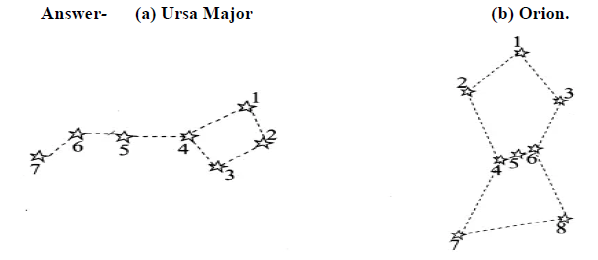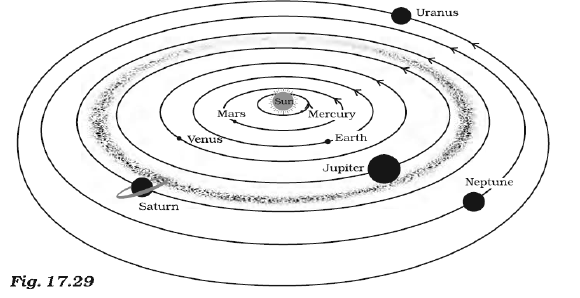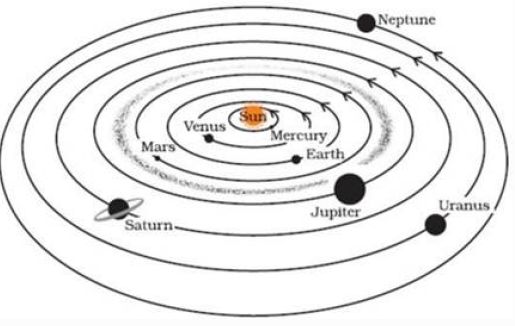STARS AND THE SOLAR SYSTEM
Question 1- Which of the following is NOT a member of the solar system?
(a) An asteroid (b) A satellite (c) A constellation (✓) (d) A comet
Question 2. Which of the following is NOT a planet of the sun?
(a) Sirius (✓) (b) Mercury (c) Saturn (d) Earth
Question 3 Phases of moon occur because
(a) We can see only that part of the moon which reflects light towards us. (✓)
(b) Our distance from the moon keeps changing.
(c) The shadow of the Earth covers only a part of the moon’s surface.
(d) The thickness of the moon’s atmosphere is not constant.
Question 4. Fill in the blanks.
(a) The planet which is farthest from the Sun is Neptune.
(b) The planet which appears reddish in colour is Mars.
(c) A group of stars, which appear to form a pattern in the sky is known a constellation.
(d) A celestial body that revolves around a planet is known as satellite.
(e) Shooting stars are actually not stars.
(f) Asteroids are found between the orbits of Mars and Jupiter.
Question 5. Mark the following statements as true (T) or false (F).
(a) Pole star is a member of the solar system. ( F )
(b) Mercury is the smallest planet of the solar system. ( T )
(c) Uranus is the farthest planet in the solar system. ( F )
(d) INSAT is the artificial satellite. ( T )
(e) There are nine planets in the solar system. ( F )
(f) Constellation Orion can be seen only with a telescope. ( F )
Question 6- Match items in column A with one or more items in column B.
Question 7. In which part of the sky can you find Venus if it is visible as an evening star?
Answer- Venus appears in the western sky just after sunset.
Question 8. Name the largest planet of the solar system.
Answer- Jupiter is the largest planet of the solar system.
Question 9. What is a constellation? Name any two constellations.
Answer- The stars forming a group that has a recognizable shape is called constellation. For example: Ursa Major and Orion.
Question 10- Draw sketches to show the relative positions of prominent stars in
(a) Ursa Major and
(b) Orion.

Question 11. Name two objects other than planets which are members of the solar system.
Answer- Satellites and asteroids are the objects that are the members of solar system.
Question 12. Explain how you can locate the Pole Star with the help of Ursa Major.
Answer- To locate the Pole Star we should look towards the northern part of the sky and identify Ursa Major. We may look at the two stars at the end of Ursa Major. A straight line passing through these stars is
imagined and is extended towards the north direction. This line leads to a star which is not too bright. This is
the Pole Star.
Question 13. Do all the stars in the sky move? Explain.
Answer- No, no star moves in sky. They appear to move from east to west, because the Earth rotates from west to east about its axis.
Question 14. Why is distance between stars expressed in light years? What do you understand by the statement that a star is eight light years away from the earth?
Answer- The distance of stars is so large that it cannot be expressed in terms of kilometer. That is why very large distances are expressed in another unit known as light year. One light year is the distance travelled by light in one year. If the distance of a star is eight light years, it means that this distance is the distance travelled by light in eight years.
Question 15. The radius of Jupiter is 11 times the radius of Earth. Calculate the ratio of the volumes of Jupiter and the earth. How many earths can Jupiter accommodate?
Answer- If the radius of the Earth is r.
Then, radius of the Jupiter is 11r.
So, we cwn say that Jupiter can accommodate 1331 earths.
Question 16. Boojho made the following sketch (fig. 17.29) of the solar system. Is the sketch correct? If not, correct it.

Answer- The positions of Mars and Venus should be interchanged. Similarly positions of Neptune and Uranus should be also interchanged.

ONE MARK MCQs
1. How many days are there between one complete (full) moon and second moon?
a) 30 days b) 27 days c) 29 days (✓) d) 31 days
2. Which star is the nearest to earth after Sun?
a) Alpha Centuri (✓) b) Pole Star c) Alpha red d) None of these
3. Why does Sun rise from the east and set in the west?
a) Because Earth rotates from East to West b) Because Earth rotates from West to East (✓)
c) Because the Earth does not rotate d) Because Sun rotates from East to West
4. What is the direction of rotation of Venus around its axis?
a) East to West (✓) b) North to South c) West to East d) South to North
5. What are the heavenly bodies called that enter the earth’s atmosphere at high speed?
a) Comet b) Pole Star c) Meteor (✓) d) Meteorites
6. What is the day called when complete moon is visible?
a) Full Moon (✓) b) Lunar Eclipse c) Amavasya d) Solar Eclipse
7. What is the star called whose position is stationary in the sky?
a) Sun b) Sirius c) Pole Star (✓) d) Moon
8. What is the brightest star in the sky called?
a) Pole Star b) Sirius (✓) c) Alpha Centuri d) Moon
9. Which is the nearest planet from Earth?
a) Mercury b) Venus (✓) c) Mars d) Saturn
10. Which planet is the nearest from Sun?
a) Mercury (✓) b) Venus c) Earth d) Saturn
11. Which is the largest planet of the Solar System?
a) Earth b) Mars c) Jupiter (✓) d) Saturn
12. Which planet is called The Red planet?
a) Earth b) Venus c) Saturn d) Mars (✓)
13. How many stars are there in the Big dipper (saptrishi) constellation?
a) Two b) seven (✓) c) Five d) Eight
14. Which of the following is not a planet of our solar system?
a) Mercury b) Mars c) Moon (✓) d) Saturn
15. Which planet has life?
a) Earth (✓) b) Venus c) Saturn d) Uranus
16. Who was the first astronaut who landed on the moon?
a) Newton b)Neil Armstrong (✓) c) Neil Bohar d) Aryabhatt
17. Which heavenly body shines brighter at the night?
a) Stars b) Planets c) Moon (✓) d) Earth
18. Suppose a new planet is found between Uranus and Neptune, then its revolution time around sun will be
a) Less than Neptune (✓) b) More than Neptune
c) Similar to Neptune & Uranus d) Less than Uranus
19. Which planet is known as Morning Star?
a) Venus (✓) b) Jupiter c) Pole star d) Sun
20. Sun seems to be larger than other stars because
a) Other stars are smaller b) other stars are less bright
c) other stars are far (✓) d) None of these
21. Earlier solar system had nine planets, but now Pluto is not the part of solar system and it has eight planets because
a) Pluto has moved far b) Pluto has broken
c) Pluto does not qualify the definition of planet (✓) d) none of these
22. Harjit singh wants to measure the distance between Sun and Earth. Which unit he will use?
a) Centimetre b) Light year (✓) c) Millimetre d) Kilometre
23. We can see moon because
a) It reflects the sunlight falling on it (✓) b) moon has its own light
c) Both (a) and (b) d) none of these
24. Which of these statements is wrong?
a) Stars produce their light b) stars are much farther than the sun
c) Sun is not a star (✓) d) sun produces its own light
25. Jaspreet sees a question mark shaped constellation in the sky. This constellation is
a) Leo major b) Orion c) Cassiopeia d) Big dipper (saptrishi) (✓)
26. Weather forecast can be done through _____?
a) Aryabhatt satellite b) artificial satellite (✓) c) INSAT d) all of these
27. Match the following:
Questions
Very Short Answer
Q1) What is astronomy?
Q2) What is full moon day?
Q3) What are celestial objects?
Q4) What are the objects which do not twinkle?
Q5) Why village sky is different from the night sky in big cities?
Short Answer
Q6) How the moon is visible to us?
Q7) What is a new moon day?
Q8) What do you mean by the phases of the moon?
Q9) Why moon appears different at different positions in its orbit?
Q10) What do you mean by the crescent moon?
Long Answer
Q11) Write short note on the moon and the moon’s surface?
Q12) State the difference between rotation and revolution?
Q13) Explain the phases of the moon?
Q14) State the difference between natural satellites and artificial satellites?
Q15) Write short note on orbit in solar system?

